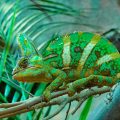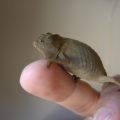- A healthy chameleon should be active in its environment and standing up rather than lying on its perch.
- The chameleon should be able to move about the cage with good balance without falling or stumbling.
- The eyes should be full, open at all times and actively looking all around.
- The arm and leg bones should all be straight, toes should all be intact and the chameleon should have a strong grip.
- The chameleon’s skin should have vibrant coloration all over the body and all the spines on the back should be present.
- Patches of shedding skin should be normal if present.
- The tail should be able to grasp branches and curl up smoothly.
Signs of an Unhealthy Chameleon:
- A chameleon that sleeps during the day.
- It has sunken or swollen eyes.
- If it is lying on the bottom of the cage.
- Legs that are bent, curved, appear to have multiple joints or have swellings at the joints.
- Wrinkly, crusty or dry skin, bumps, cuts or bruises, or patches of abnormal colored skin.
- Blood at the mouth, swollen jaw, or jaw that doesn’t align properly.
- A tail that cannot curl or is black at the end.
- If your chameleon is falling off branches, having a weak grip, stumbling or appearing very clumsy.






 Author and long-time animal lover. Sharing knowledge on pet care through experience and the written word.
Author and long-time animal lover. Sharing knowledge on pet care through experience and the written word.